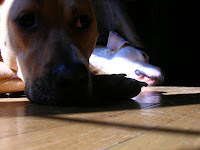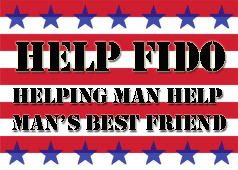Hello all! My name is Dr. Mandi Maimone. Most call me
Dr. Mandi or Dr. M. I am a 2004 graduate of
The Ohio State University College of Veterinary Medicine in Columbus, Ohio and have been in the veterinary business for about 17 years now. I currently practice small animal medicine (which means that the majority of my patients are dogs and cats) in Central Ohio. I am also a founding member of
HELP FIDO. Although I now live in the Columbus area, I have lived most of my life in New York City. Much of my work in New York involved interaction with and treatment of bully breed dogs. They are very near and dear to my heart. I also spent time working at
The New York Zoological Society also known as the Bronx Zoo. That was lots of fun!!
My purpose here is to provide all of you with medical and behavioral knowledge and information regarding not just bully breeds but all of our furry canine friends. This time around I would like to talk about a behavioral problem all dog owners have had to deal with (including myself!!) and that is CHEWING!
DESTRUCTIVE CHEWING is very common. Puppies investigate their enviornment by sniffing, tasting and perhaps chewing on objects as part of their normal behavior. Adult dogs might chew when they are searching for food, playing or merely as a means of satisfying a natural urge to chew and gnaw on objects. In some cases, chewing might be an attention seeking behavior even if it yields negative attention or results in chasing or scolding by their owners. Anxiety, conflict, or high-arousal situations may result in destruction and chewing of the owner's possessions and perhaps attempts to escape by chewing windows, doors or the area in which the dog is confined.
The dog may chew to escape or roam because of inadequate exercise, stimulation or environmental enrichment. In rare instances, chewing is accompanied by ingestion of inappropriate objects (pica), which may be caused by a compulsive disorder. This can be a very dangerous situation if the dog develops an intestinal obstruction. This is where I come in, since surgery is many times required to remove these obstructive objects. Surgical procedures can be very risky for your pet and can also be very costly to you.
The first step in treating chewing behavior is to IDENTIFY THE UNDERLYING MOTIVATION. Young dogs and puppies that chew inappropriate items may be engaging in play and exploration. Getting into garbage or other food areas is usually a food seeking behavior and may be part of normal dog behavior or may occur when the dog is on a calorie-restricted diet. Dogs that chew at windows, doors or their crates may suffer from separation anxiety, or may be reacting to outside stimuli. Repetitive chewing that is dificult to distract or redirect might be related to obsessive compulsive disorder. Dogs that are diagnosed with this condition may also chew obsessively on certain areas of their own bodies like the carpus (wrist) or hock, causing sores that may take a very long time to heal and require medical treatment. Intact animals (dogs that are not spayed or neutered) may attempt to escape to roam and seek a mate. Dogs with limited opportunity for social interaction, playtime, exercise, walks and poor enviornmental enrichment may chew as a way to combat boredom.
Keeping a daily diary of chewing episodes, frequency and where such episodes occur may help to determine underlying motivation and contributing factors. If the problem occurs when the owner is absent, a videotape may help determine whether separation anxiety or an environmental stimulus such as noise is the source of the problem.
Treatment options vary depending on the type of chewing behavior as well as the reason behind the behavior. Destructive chewing resulting from separation anxiety, noise phobia (such as to thunderstorms or fireworks) or territorial aggression may require consultation with your veterinarian, a board certified behaviorist, trainer or a combination of some or all of these individuals. These dogs frequently require medication (and therefore close veterinary monitoring of administration of medication and possible side effects), which aids in behavioral modification in order to effectively treat them for these problems.
Other destructive chewing behaviors respond to PREVENTIVE MEASURES. You may begin treatment by redirecting chewing to suitable and appealing alternatives, providing sufficient play and exercise, and preventing access to previously chewed items. Avoid all rewards, either purposeful or inadvertant. Keep food completely out of reach, secure trash and garbage, and avoid chasing the dog and playful tugging at "stolen" items. Preventing access to areas where the dog might chew is essential. Baby gates, closed doors, and leash control all help prevent unwanting chewing.
If destructive chewing occurs in confinement, other measures may be needed such as teaching the dog how to be comfortable while confined or treating any underlying anxiety that may be contributing to the behavior.
Provide
OUTLETS FOR CHEWING. Rather than focusing on punishment, it is more appropriate to provide acceptable outlets for chewing. Give the dog a choice of chew toys to determine which ones it finds most appealing. Some dogs prefer plastic, nylon or rubber toys while others prefer edible items that are safe to be ingested. Augmenting these toys with food often increases their desirability. For example, my dogs enjoy their
Kong rubber chew toy filled with peanut butter. I find that placing the toy in the freezer lengthens the time they are interested in the toy by making the peanut butter last much longer.
Be sure to provide durable toys so that small pieces may not be chewed off and ingested, as well as toys that are appropriate your dogs' size and breed.
One side note, it is very important to NEVER, EVER give your dog natural bones to chew on. Natural bones like chicken, pork, steak, rib, turkey, beef or any bone like these can easily splinter causing tearing or puncture of the stomach or intestinal lining, can cause obtruction requiring surgery, or cause severe vomiting and/or diarrhea. Any or all of these conditions can be life threatening to your pet.
Reward your dog with attention and praise for chewing appropriate items. You must also check items regularly and remove any damaged ones to avoid inadvertant ingestion of broken or splintered toys.
SUPERVISION, EXERCISE AND REPRIMANDS are also an important part of the equation as long as they are performed appropriately. Supervise puppies at all times to prevent chewing on inapproapriate objects and to encourage them to use the toys provided. If supervision is not possible, prevent access to any chewable object or area where chewing may occur.
A dog needs ample opportunity to explore and play in a regular, predictable routine, including social interacions, play, training and exercise. For many dogs a daily walk can be very calming and provides exercise and stimulation. Also, formal training classes can be fun and entertaining for both pet and owner.
A dog should be reprimanded for chewing ONLY if it is caught in the act. All reprimands must be immediate, humane and controlled. Inappropriate reprimands can lead to fear and defensive reactions in some dogs, or may serve as a form of negative attention and reinforcement of undesireable behaviors in others.
Another option is to make the areas where the dog is likely to chew adversive. Taste or odor aversion is often the easiest and most practical intervention, but not all pets are deterred by these types of products, especially if no other appropriate outlets for play and exploration are offered. Because chewing is an inherently rewarding behavior, some form of chewing may be a lifelong habit for some dogs. Always make sure you consult your veterinarian before purchasing or using any of these products as some may not be safe for your pet.
Overall, the best advice I can offer is to take the time to discover the reason behind your dogs' destructive chewing and explore your options carefully. You know your pet best. So work with your veterianian, behaviorist, trainer to devise a plan that works for you, your family and your dog. This way everybody is happy in the end.
Thats all for now.
Dr. Mandi
(PS - I need to acknowlegde
Dr. Debra F. Horowitz, DVM, Diplomate ACVB, Veterinary Behavior Consultations, St. Louis, Missouri and her article in NAVC Clinician's Brief for some of the information contained in this blog.)














